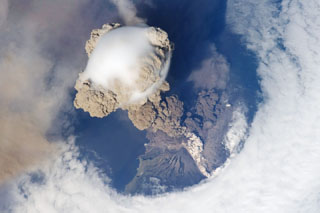Report on Sarychev Peak (Russia) — 20 January-26 January 2021
Smithsonian Institution / US Geological Survey
Weekly Volcanic Activity Report, 20 January-26 January 2021
Managing Editor: Sally Sennert.
Please cite this report as:
Global Volcanism Program, 2021. Report on Sarychev Peak (Russia) (Sennert, S, ed.). Weekly Volcanic Activity Report, 20 January-26 January 2021. Smithsonian Institution and US Geological Survey.
Sarychev Peak
Russia
48.092°N, 153.2°E; summit elev. 1496 m
All times are local (unless otherwise noted)
KVERT reported that lava began to effuse from a vent in Sarychev Peak’s summit crater 10 January, and by 20 January it had traveled about 400 m down the N flank. A gas-and-steam plume drifted 36 km NE on 12 January. A thermal anomaly was visible during 15 and 18-21 January. The Aviation Color Code remained at Yellow (the second lowest level on a four-color scale).
Geological Summary. Sarychev Peak, one of the most active volcanoes of the Kuril Islands, occupies the NW end of Matua Island in the central Kuriles. The andesitic central cone was constructed within a 3-3.5-km-wide caldera, whose rim is exposed only on the SW side. A dramatic 250-m-wide, very steep-walled crater with a jagged rim caps the volcano. The substantially higher SE rim forms the 1496 m high point of the island. Fresh-looking lava flows, prior to activity in 2009, had descended in all directions, often forming capes along the coast. Much of the lower-angle outer flanks of the volcano are overlain by pyroclastic-flow deposits. Eruptions have been recorded since the 1760s and include both quiet lava effusion and violent explosions. Large eruptions in 1946 and 2009 produced pyroclastic flows that reached the sea.

